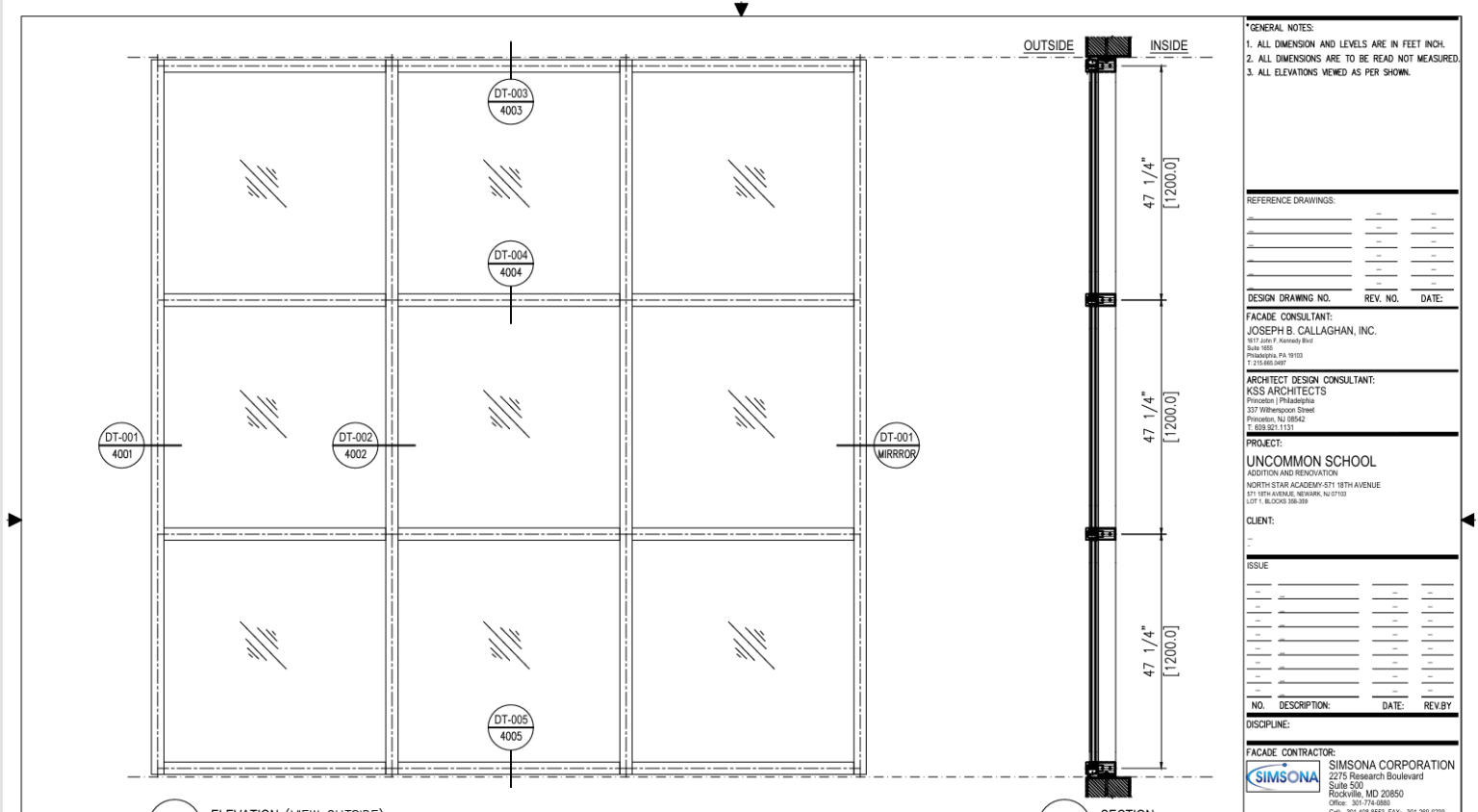What is a Curtain Wall Shop Drawing?
A curtain wall shop drawing is a detailed, scaled, and technically precise representation of a curtain wall system, created by facade engineers, drafters, or steel/glass fabricators. Unlike architectural drawings, which convey design intent, shop drawings provide fabrication and installation-level details. They act as a bridge between the architectural concept and the on-site execution.
These drawings are typically created using BIM or CAD platforms and form part of the submittals reviewed and approved by architects, consultants, and general contractors before fabrication begins.
Components of Curtain Wall Shop Drawings
Comprehensive Title Block and Drawing Index
Every shop drawing begins with a title block. It’s a standardized frame that holds essential information like the project name, sheet number, drawing scale, the date of creation or revision, and the name of the detailing company. In large drawing sets, all such information helps in quick identification of relevant drawings.
Alongside a drawing index list all included drawings, which helps in easy navigation across different parts of the curtain wall system.
Plan Views: The Façade’s Footprint
Plan views give a top-down perspective of the curtain wall system in relation to the building’s structural grid, slab edges, and perimeter beams. The views illustrate how the curtain wall aligns with structural elements and outline panel spacing, bracket locations, and anchor points.
It’s a bird’s-eye view that fabricators and site engineers rely on for precise wall placement.
Elevation Views: The Wall as It Appears
Elevation views present a front-facing visual of each building façade. These drawings show the vertical and horizontal divisions, including mullions, transoms, and glass panels. Elevations typically include floor levels, panel numbers, and alignment with architectural gridlines. This is the visual map that brings the design concept to life in its full scale.
Vertical and Horizontal Sections
Sectional drawings cut through the wall system to reveal its internal structure and depth. Vertical sections show how the wall connects from floor to floor, while horizontal sections show the interactions between mullions, glass, and insulation layers. These sections are crucial for understanding thermal breaks, gasket positions, and air-water barriers, ensuring the system performs in various environmental conditions.
Anchoring and Structural Connections
One of the most critical aspects of a curtain wall is how it attaches to the building frame. Shop drawings include detailed illustrations of brackets, embeds, anchors, and fixing systems. These components ensure the façade can withstand wind loads, seismic activity, and thermal movement. Every connection is drawn with precise measurements and fastener types and often includes torque specifications for proper installation.
Mullion and Transom Detailing
Mullions (vertical members) and transoms (horizontal members) form the skeleton of the curtain wall. The shop drawings detail their profile dimensions, reinforcements, splice locations, and how they support glass or panel inserts. These drawings also clarify how internal drainage systems and pressure plates function within the frame.
Glazing and Panel Information
Each panel of glass or opaque material is specified in detail. Shop drawings include the glass thickness, type (e.g., laminated, insulated, or tempered), coating, and performance data like U-value or solar heat gain coefficient. For opaque areas, materials such as aluminium composite panels (ACP) or stone cladding may also be specified. This information ensures thermal performance, light control, and safety standards are met.
Sealant and Gasket Details
Watertightness and airtightness are essential for any façade. Curtain wall shop drawings clearly identify all silicone sealant joints, EPDM gaskets, and interface materials. These details show where materials must be applied, how wide joints should be, and the sequencing for weatherproofing. It all acts as a crucial guide for installers.
Thermal and Moisture Management Strategy
Modern curtain walls must manage not only structure and aesthetics but also thermal insulation and moisture control. The drawings often highlight vapor barriers, thermal breaks, insulation zones, and weep systems that drain water. These details are essential to prevent condensation, reduce thermal bridging, and enhance building envelope performance.
Fabrication Notes and Assembly Guidelines
To streamline manufacturing, the shop drawings contain precise fabrication instructions in the form of cut lengths, drill hole locations, weld sizes, and assembly notes. These guidelines are used by the curtain wall fabricator to produce accurate components that will fit perfectly on-site, saving both time and cost during construction.
Installation Instructions and Site Considerations
Installation is where all design and fabrication efforts come together. The shop drawings include installation sequencing, panel lifting instructions, and alignment procedures. They may also show coordination with slab edges, parapets, and other façade systems like louvers or sunshades. These are practical guides that ensure safety and consistency during erection.
Bill of Materials (BOM)
A bill of materials is a complete inventory list of every component required to construct the curtain wall. It includes extrusions, brackets, bolts, gaskets, sealants, and glass. Each item has part numbers, quantities, and specifications, which ensure nothing is missed during procurement and assembly.
Code Compliance and Testing Notes
Compliance with regulations is an important requirement in today’s modern construction. Shop drawings often include compliance notes, references to ASTM standards, or results from performance mock-ups and lab testing. It validates the ability of the system to withstand air, water, and structural loads.
Revision History and Version Control
Finally, when every change is made in the shop drawings, then these changes must be tracked. The revision history shows what was updated, when, and why. It ensures every stakeholder’s work is from the latest approved version. Latest versions help in avoiding costly mistakes due to outdated references.
Conclusion
Curtain wall shop drawings are not just blueprints—they are the instruction manual, specification sheet, and legal document for the entire façade system. They ensure design intent is faithfully executed, performance criteria are met, and installation is smooth. Understanding these key components allows stakeholders to communicate effectively and deliver a flawless building envelope.



